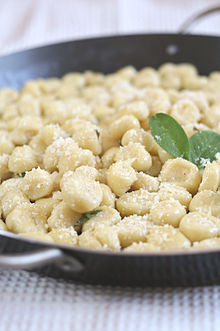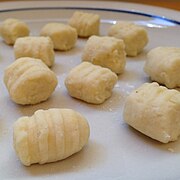Gnocchi
 | |
| Type | Dumpling |
|---|---|
| Course | Primo (Italian course) |
| Place of origin | Italy |
| Main ingredients | Potatoes, semolina, wheat flour, breadcrumbs, sometimes eggs, cheese |
| Similar dishes | Gnudi |
Gnocchi (/ˈn(j)ɒki/ N(Y)OK-ee,[1] US: /ˈn(j)oʊki, ˈn(j)ɔːki/ N(Y)OH-kee, N(Y)AW-;[2][3][4][5] Italian: [ˈɲɔkki]; sg.: gnocco) are a varied family of dumplings in Italian cuisine.[6] They are made of small lumps of dough, such as those composed of a simple combination of wheat flour,[7] potato,[8] egg,[9] and salt. Variations of the dish supplement the simple recipe with flavour additives, such as semolina flour,[10] cheese,[11] breadcrumbs,[12] cornmeal[13] or similar ingredients,[14][15][16] and possibly including herbs, vegetables, and other ingredients. Base ingredients may be substituted with alternatives such as sweet potatoes for potatoes or rice flour for wheat flour. Such variations are often considered to be non-traditional.[13]
Gnocchi are commonly cooked in salted boiling water and then dressed with various sauces.[13] They are usually eaten as a first course (primo) as an alternative to soups (minestre) or pasta, but they can also be served as a contorno (side dish) to some main courses.[13] Common accompaniments of gnocchi include melted butter with sage, pesto, and various sauces. Gnocchi may be homemade, made by specialty stores, or produced industrially and distributed refrigerated, dried, or frozen. Small soup gnocchi are sometimes made by pressing the dough through a coarse sieve or a perforated spoon.
Origin
[edit]
The word gnocchi may be derived from the Italian word nocchio, meaning 'a knot in wood',[17] or from nocca, meaning 'knuckle'.[18] It has been a traditional Italian dish since Roman times.[6][contradictory] It was introduced by the Roman legions during the expansion of the empire into the countries of the European continent. One ancient Roman recipe consists of a semolina porridge-like dough mixed with eggs; similar modern dishes include the baked gnocchi alla romana and Sardinian malloreddus,[19] which do not contain eggs.
After potatoes were introduced to Europe, they were eventually[when?] incorporated into gnocchi recipes.[20] Potato gnocchi are particularly popular in Lombardy, Abruzzo, Friuli-Venezia Giulia, Veneto, and Lazio.
Ingredients and preparation
[edit]

Ingredients typically include wheat flour,[7] potato,[8] egg,[9] and salt. Variations of the dish supplement the simple recipe with flavour additives, such as semolina flour,[10] cheese,[11] breadcrumbs,[12] cornmeal[13] or similar ingredients,[14][15][16] and possibly including herbs, vegetables, and other ingredients.
The dough for gnocchi is often rolled out before it is cut into small pieces about the size of a wine cork or smaller.[21] The dumplings may be pressed with a textured object, such as a fork or a cheese grater, to make ridges or cut into little lumps.[13] Professional tools exist for this purpose, known as gnocchi or cavarola boards.
Gnocchi that are homemade are usually consumed the same day they are made. However, they can be cut into bite-sized dumplings, spread evenly on a baking sheet, frozen, then packaged in an air-tight bag and back into the freezer for later consumption. This method can allow the gnocchi to last two months in the freezer.
Commercial gnocchi are often sold under modified atmospheric packaging and may achieve a shelf life of two weeks or more under refrigeration.[22][23] Some are sold in vacuum packaging that is shelf-stable, only needing refrigeration once it is opened.[24]
Varieties
[edit]This section needs additional citations for verification. (March 2019) |
Gnocchi vary in recipe and name across different regions.
Regional
[edit]Lombard and Tuscan malfatti (lit. 'poorly made') are made with ricotta, flour, and spinach, as well as the addition of various other herbs if required.[13][25] Tuscan gnudi distinctively contains less flour;[26] but some varieties are flour-based, such as the Campanian strangulaprievete, the Apulian cavatelli, the Sardinian malloreddus,[19] and so on.[27] Certain kinds are made of cooked polenta or semolina, which is spread out to dry, layered with cheese and butter, and baked.[13]
Gnocchi di pane (lit. 'bread lumps'), derived from the Semmelknödel, is made from breadcrumbs and is popular in Friuli-Venezia Giulia, Veneto, and Trentino-Alto Adige. Another variety from the latter region is spinach gnocchi.
International
[edit]Austria
[edit]In Austria, gnocchi are a common main or side dish, known by the original name and Austrian variant, nockerl (pl.: nockerln). As a side dish, they may accompany main dishes such as goulash.
Croatia
[edit]Gnocchi are very popular and often served as a dish in coastal Croatia, typically being served as a first course or a side dish with dalmatinska pašticada. The Croatian name for gnocchi is njoki.[28]
Slovenia
[edit]Gnocchi, known locally as njoki, are common in Slovenia's Primorska region, which shares many of its culinary traditions with neighboring Italy.
France
[edit]In France, gnocchis à la parisienne is a hot dish of dumplings made of choux pastry[29] served with béchamel sauce.
A specialty of Nice, gnocchi or gnoques de tantifla a la nissarda[30] are made with potatoes, wheat flour, and eggs. Another version including blette (Swiss chard) is called merda dé can (lit. 'dog shit'[31]).
In Provence, potato gnocchi can be made in a longer shape called longettes.[32]
South America
[edit]Due to the significant number of Italian immigrants who arrived in Argentina, Paraguay, and Uruguay, gnocchi, ñoqui (Spanish: [ˈɲoki]), or nhoque (Portuguese: [ˈɲɔki]), is a popular dish, even in areas with few Italian immigrants. In Uruguay, Paraguay, and Argentina, there is a tradition of eating gnocchi on the 29th of each month, with some people putting money beneath their plates to bring prosperity.[33][34] Indeed, in Argentina and Uruguay ñoqui is slang for a bogus employee (according to corrupt accountancy practices or, in the public sector, the distribution of political patronage), who only turns up at the end of the month to receive their salary.[35]
Gallery
[edit]See also
[edit]![]() Media related to Gnocchi (dumplings) at Wikimedia Commons
Media related to Gnocchi (dumplings) at Wikimedia Commons
References
[edit]- ^ "gnocchi". Lexico UK English Dictionary. Oxford University Press. Archived from the original on 2019-12-16.
- ^ "gnocchi". Merriam-Webster.com Dictionary. Merriam-Webster. Retrieved 2 October 2019.
- ^ "gnocchi". Dictionary.com Unabridged (Online). n.d. Retrieved 2 October 2019.
- ^ "gnocchi". The American Heritage Dictionary of the English Language (5th ed.). HarperCollins. Retrieved 2 October 2019.
- ^ "gnocchi". Collins English Dictionary. HarperCollins. Archived from the original on 2 October 2019. Retrieved 2 October 2019.
- ^ a b Serventi, Silvano; Sabban, Françoise (2002). Pasta: The Story of a Universal Food. Translated by Shugaar, Antony. New York: Columbia University Press. pp. 42. ISBN 0-231-12442-2.
- ^ a b Buonassisi, recipe #831-833
- ^ a b Buonassisi, recipe #854-857
- ^ a b Buonassisi, recipe #837-838
- ^ a b Vincenzo Buonassisi, Il nuovo codice della pasta, Rizzoli 1985, recipe #850-853
- ^ a b Buonassisi, recipe #839-840
- ^ a b Buonassisi, recipe #877 "Al Pien... si tratta di gnocchi, delicatissimi, secondo un'antica ricetta mantovana..."
- ^ a b c d e f g h Riley, Gillian (2007). The Oxford Companion to Italian Food. Oxford: Oxford University Press. ISBN 978-0-19-860617-8.
- ^ a b Waverley Root, The Food of Italy, 1971 passim
- ^ a b Luigi Carnacina, Luigi Veronelli, La cucina rustica regionale (4 vol.), Rizzoli 1966, passim
- ^ a b Accademia Italiana della Cucina, La Cucina: The Regional Cooking of Italy, tr. Jay Hyams, Rizzoli, 2009, passim
- ^ "gnocchi, n." Oxford English Dictionary. Archived from the original on 2015-11-05. Retrieved 2010-12-18.
- ^ Lo Zingarelli, 2008.
- ^ a b Farley, David (October 20, 2017). "The Perfect Pasta Dish Sardinians Refuse to Share". BBC. Archived from the original on September 12, 2018. Retrieved September 15, 2018.
- ^ Theisen, K. "World Potato Atlas: China - History and Overview." International Potato Center.
- ^ Davidson, Alan (2014). "Gnocchi". In Jaine, Tom (ed.). The Oxford Companion to Food (3rd ed.). New York, NY: Oxford University Press. doi:10.1093/acref/9780199677337.001.0001. ISBN 978-0-19-967733-7.
- ^ Ohlsson, T.; Bengtsson, N., eds. (2002). Minimal Processing Technologies in the Food Industries. Cambridge: Woodhead Publishing. ISBN 1-85573-547-4.
- ^ Alessandrini, Laura; Balestra, Federica; Romani, Santina; Rocculi, Pietro; Rosa, Marco Dalla (2010). "Physicochemical and Sensory Properties of Fresh Potato-Based Pasta (Gnocchi)". Journal of Food Science. 75 (9): S542–S547. doi:10.1111/j.1750-3841.2010.01842.x. PMID 21535629.
- ^ "Sam's Choice Italia Potato Gnocchi". Walmart. Retrieved April 29, 2022.
Third image: Store in a cool and dry place (MAX 25°C). Once opened, keep refrigerated for max three days.
- ^ Buonassisi, recipe #875
- ^ Royer, Blake (April 15, 2010). "Homemade Gnudi from The Spotted Pig". The Paupered Chef. Archived from the original on 2014-05-12. Retrieved 2014-05-12.
- ^ Buonassisi, recipe #895
- ^ MacGregor, Sandra (June 17, 2013). "Varazdin: Croatia's 'Little Vienna'". The Telegraph. Archived from the original on November 6, 2016. Retrieved November 5, 2016.
- ^ Gray, Marlene Sorosky (April 4, 2010). "Bay Area Chefs Put Twists on Traditional French Pastry". SFGate. Archived from the original on November 6, 2016. Retrieved November 5, 2016.
- ^ Médecin, Jacques. La cuisine du Comté de Nice.
- ^ Frommer, Arthur (2000). Frommer's Europe. Macmillan USA. p. 397. ISBN 978-0-02-862995-7.
...the unfortunately named merda de can (lit. 'dog shit'), which is gnocchi stuffed with spinach - it's a lot more appetizing than it sounds.
- ^ Larousse, Librairie (2022-08-30). Larousse Gastronomique: The World's Greatest Culinary Encyclopedia, Completely Revised and Updated. Clarkson Potter/Ten Speed. ISBN 978-0-593-57774-5.
- ^ McClaughlin, Kate (January 29, 2011). "New World Gnocchi". The Wall Street Journal. Archived from the original on January 27, 2016. Retrieved January 21, 2016.
- ^ Schneider, Laura (February 4, 2014). "How Eating Italian Gnocchi Became a Monthly Tradition in Latin America". Global Voices. Archived from the original on August 13, 2018. Retrieved January 21, 2016.
- ^ "'I Am Not a Ñoqui' – The Story Behind the State's Mass Layoffs". Argentinaindependent.com. Archived from the original on 25 April 2018. Retrieved 15 September 2018.
Further reading
[edit]- Davidson, Alan. The Oxford Companion to Food, s.v. gnocchi.
- Jenkins, Nancy Harmon. Flavors of Tuscany. 1998.
- Garnerone, Myriam. "Traditions et Cuisine du pays niçois, Recettes Niçoises de nos Grands-Mères". 2008.











